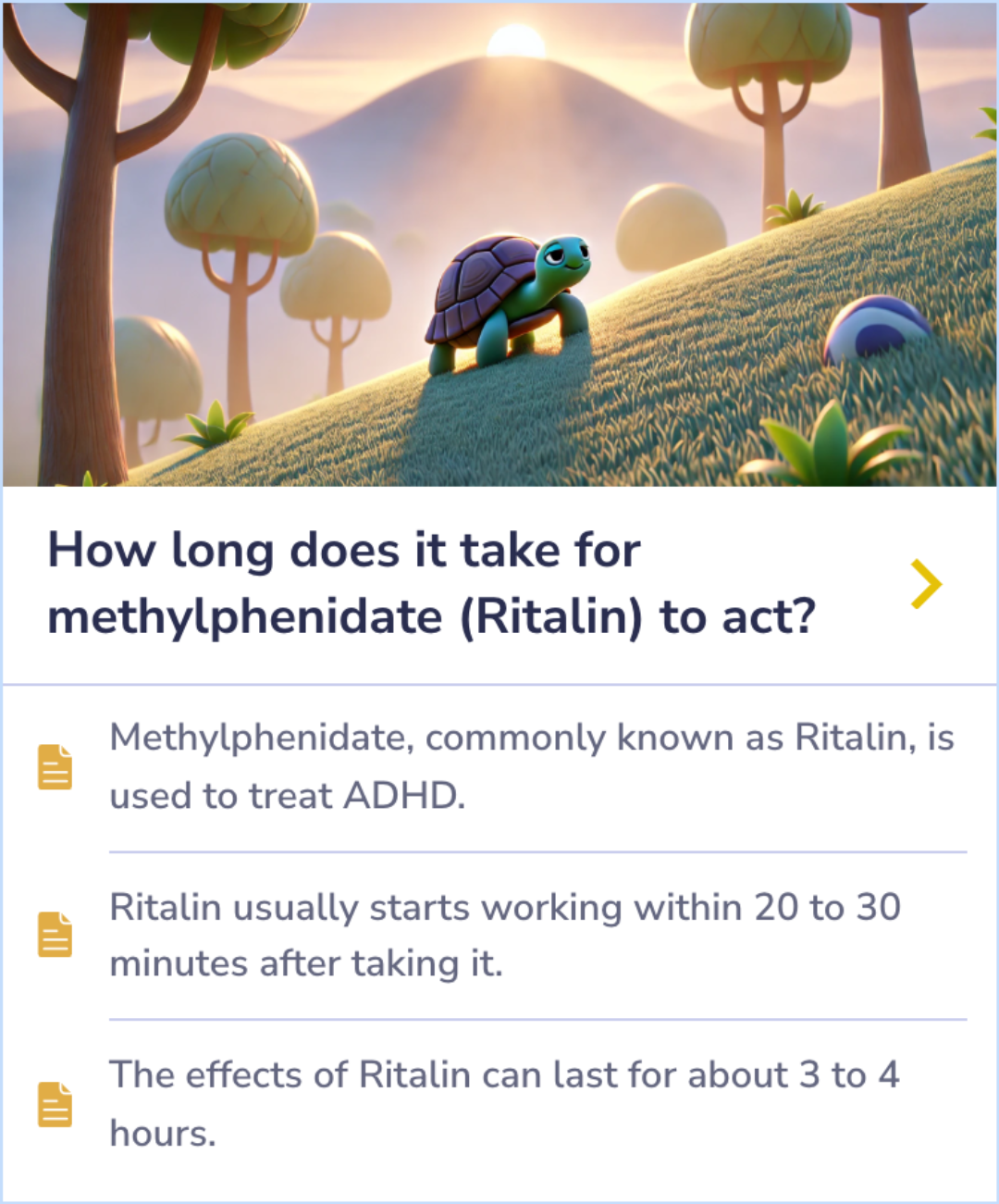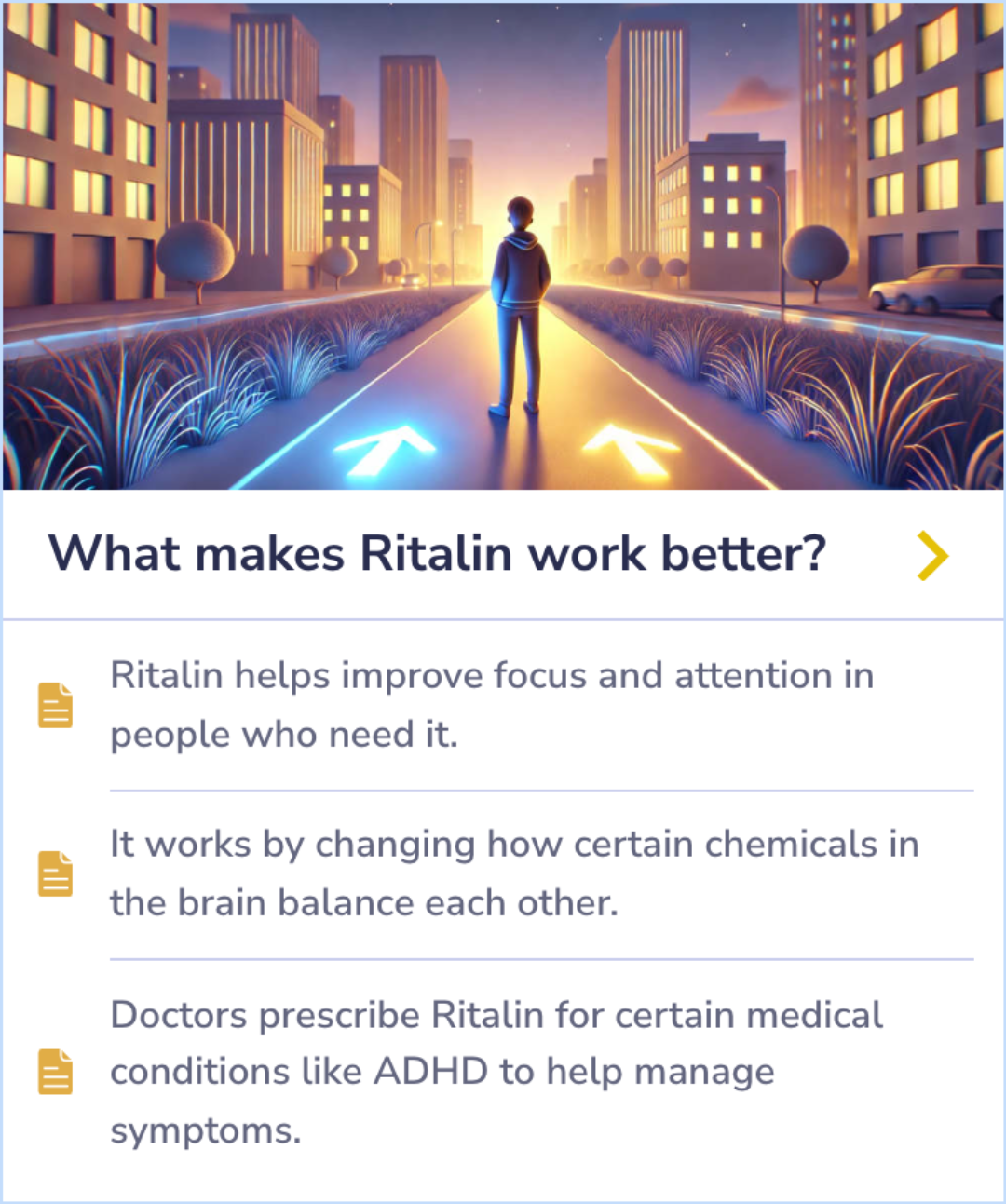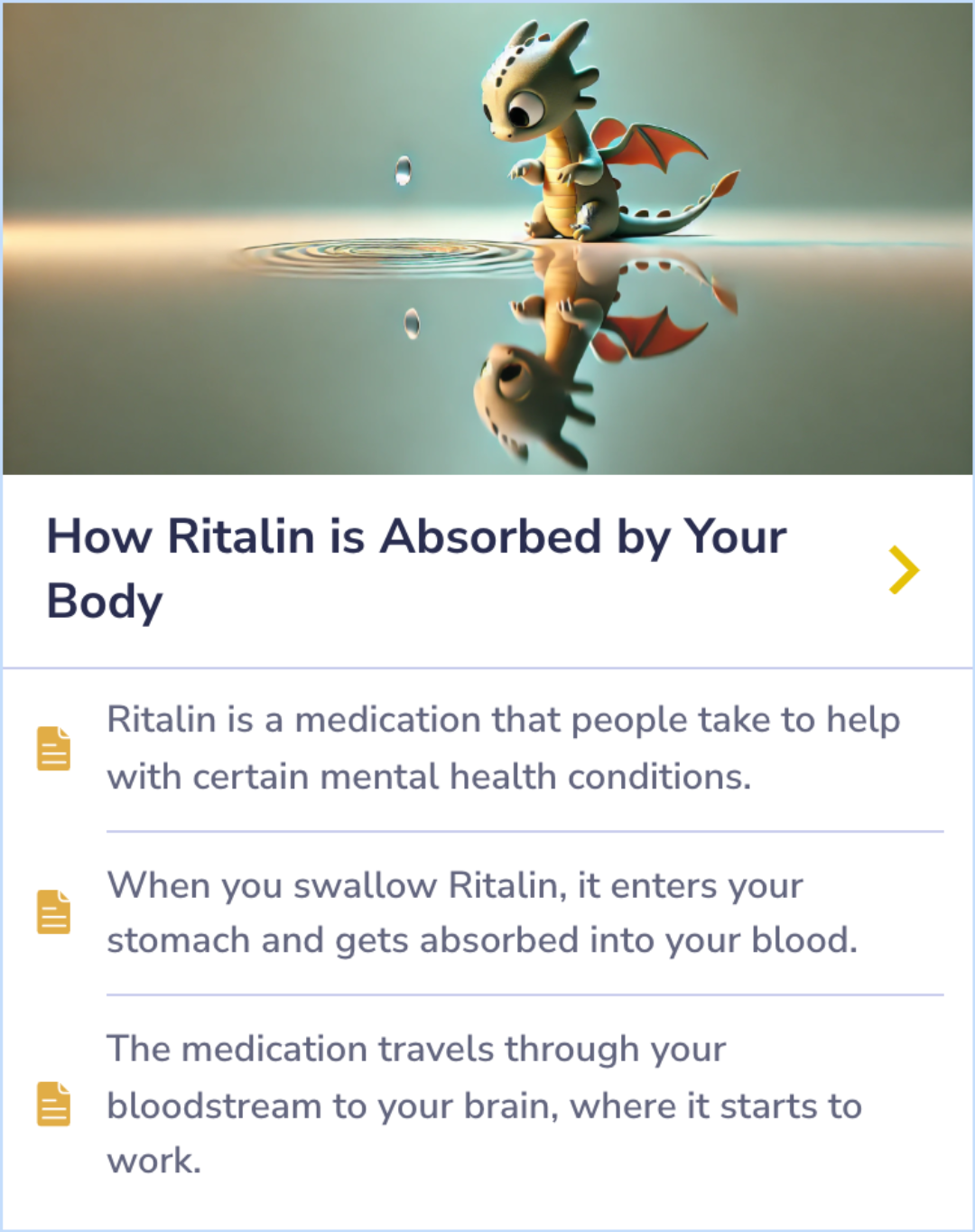Ritalin
Evidence Based Answers
When is Ritalin at its peak?
Methylphenidate without ADHD may alter dopamine levels, leading to potential misuse for non-medical cognitive enhancement, raising risks and ethical concerns.
Published: November 2, 2024
Click to explore a section:
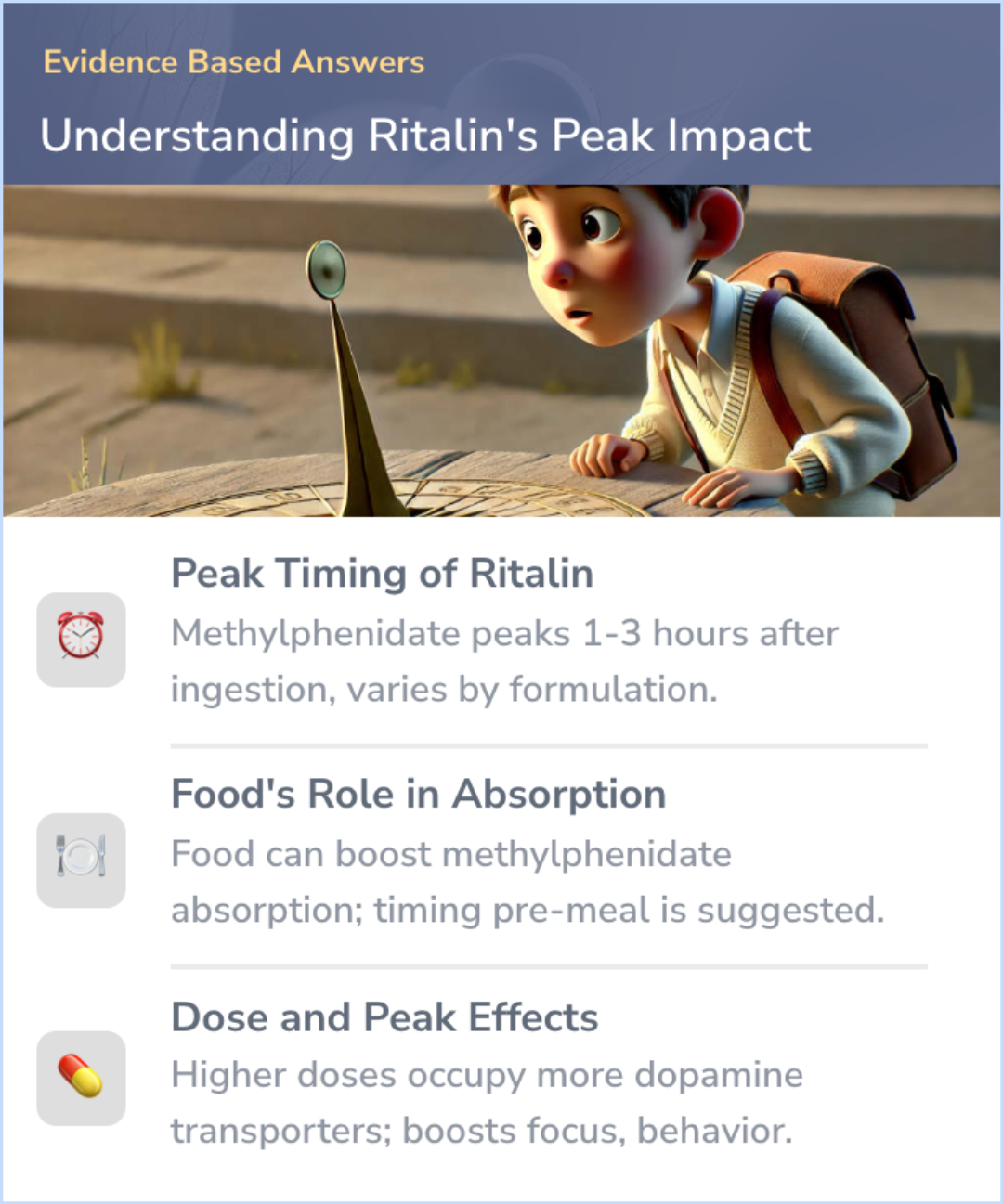
Ritalin peaks 1-3 hours post-ingestion; food affects absorption, dose influences effects.
Timing of Peak Concentration
Methylphenidate reaches its highest concentration (Cmax) in the blood between 1 to 3 hours after taking it. This timing, called Tmax, shows when the drug's effects are strongest.
For immediate-release tablets, peak levels are typically reached at 1.9 hours, while extended-release tablets peak around 4.7 hours.
Food can affect absorption; taking methylphenidate with food may increase the peak concentration, making it important to consider timing when taking the medication.
For immediate-release tablets, peak levels are typically reached at 1.9 hours, while extended-release tablets peak around 4.7 hours.
Food can affect absorption; taking methylphenidate with food may increase the peak concentration, making it important to consider timing when taking the medication.
“
Source Quotes:
Peak plasma concentrations (Cmax) occur 1 to 3 hours (Tmax) after an oral dose of standard methylphenidate.
Time of peak plasma concentration: 1.9 hours for immediate-release tablets and 4.7 hours for extended-release tablets.
Effect of Food on Medication Absorption
Taking methylphenidate with food can change how quickly and strongly the medication is absorbed. Food intake before taking the medication may enhance its peak levels.
The recommendation is often to take it 30 to 45 minutes before meals to avoid food interference.
This highlights the importance of timing and consistency in how the medication is taken to ensure consistent results.
The recommendation is often to take it 30 to 45 minutes before meals to avoid food interference.
This highlights the importance of timing and consistency in how the medication is taken to ensure consistent results.
“
Source Quotes:
Current clinical practice calls for the administration of methylphenidate 30 to 45 minutes before meals because the presence of food may interfere with the absorption of the drug.
Food effects: Increase total exposure and peak plasma concentration; reduce the time for peak plasma concentration for extended-release tablets.
Dose and Peak Effects
Methylphenidate's effects are influenced by the dose taken, affecting how much of the brain's dopamine transporters are occupied.
Research shows that at therapeutic doses, over half of the brain's dopamine transporters can be occupied, which is linked to improvements in focus and behavior.
Understanding this relationship helps in determining effective doses for treatment.
Research shows that at therapeutic doses, over half of the brain's dopamine transporters can be occupied, which is linked to improvements in focus and behavior.
Understanding this relationship helps in determining effective doses for treatment.
“
Source Quotes:
At oral therapeutic doses (0.3–0.6 mg/kg), methylphenidate is estimated to occupy more than half of brain dopamine transporters.
Methylphenidate blocks the reuptake of two neurotransmitters, norepinephrine (NE) and dopamine, in presynaptic neurons.
Key Takeaways
Conclusions
Ritalin, known generically as methylphenidate, reaches its peak effect based on both the formulation and the timing of ingestion. Immediate-release forms typically peak at around 1.9 hours after consumption, while sustained-release versions may take up to 4.7 hours.
Moreover, consuming Ritalin with food can alter its absorption, potentially leading to quicker peak effects. Dosing also plays a role, with therapeutic levels occupying a significant portion of dopamine transporters to enhance behavioral outcomes.
Moreover, consuming Ritalin with food can alter its absorption, potentially leading to quicker peak effects. Dosing also plays a role, with therapeutic levels occupying a significant portion of dopamine transporters to enhance behavioral outcomes.
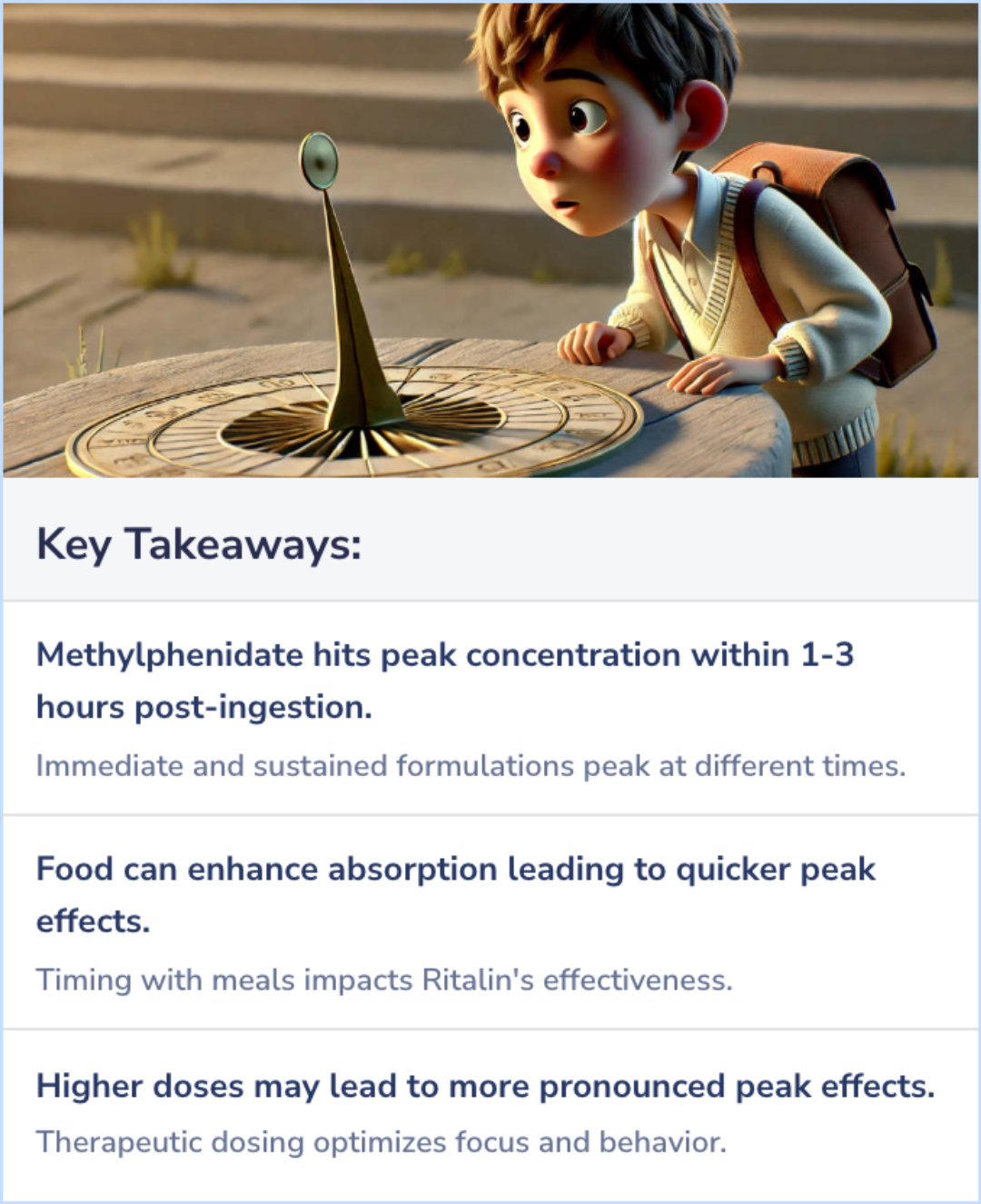
Background: Adult Instructions
Immediate-release Ritalin tablets are typically taken 2 to 3 times per day, scheduled 30 to 45 minutes before meals for optimal absorption.
For sustained-release (SR) forms, a single dose provides an 8-hour effect, helping to maintain symptom control throughout the day without the need for multiple doses.
For sustained-release (SR) forms, a single dose provides an 8-hour effect, helping to maintain symptom control throughout the day without the need for multiple doses.
Evidence Summary
Quick-Acting Relief: How Ritalin Fits Into Daily Life
Ritalin, a common ADHD medication, starts working quickly, usually within 20 to 30 minutes. Its effects provide a short window, lasting about 3 to 4 hours, allowing for targeted symptom relief during crucial parts of the day.
Planning doses around this timing helps manage daily routines and achieve a smoother schedule for activities that require focus and attention.
Planning doses around this timing helps manage daily routines and achieve a smoother schedule for activities that require focus and attention.
Evidence Summary
How Ritalin Enhances Focus and Attention
Ritalin boosts focus and attention by adjusting brain chemicals to help manage ADHD symptoms. It enables people who need it to concentrate more effectively, addressing specific challenges in daily activities.
The medication works by balancing certain brain chemicals that affect alertness and impulse control. This targeted action makes it a common choice for those struggling with ADHD.
Doctors often prescribe Ritalin to improve attention and reduce distractibility in patients needing support for their condition.
The medication works by balancing certain brain chemicals that affect alertness and impulse control. This targeted action makes it a common choice for those struggling with ADHD.
Doctors often prescribe Ritalin to improve attention and reduce distractibility in patients needing support for their condition.
Evidence Summary
How Ritalin Travels from Stomach to Brain
Ritalin, commonly used to help manage mental health symptoms, starts its journey in your stomach. After you swallow it, the medication gets absorbed into the bloodstream, traveling through your body until it reaches your brain.
Once there, Ritalin acts to regulate brain activity, targeting specific symptoms. This pathway highlights how Ritalin moves through your system to deliver its effects where they're needed most.
Once there, Ritalin acts to regulate brain activity, targeting specific symptoms. This pathway highlights how Ritalin moves through your system to deliver its effects where they're needed most.
